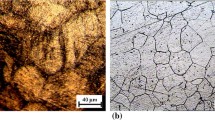Abstract
The flow properties of β-phase Zr-Mo alloys were investigated by means of compression testing in a nominally pure (10 ppm O2) argon atmosphere. Experiments were carried out in the strain rate range 10-1 to 10-5 s-1 and from 900 to 1000°C. The stress-strain curves were unusual in that they exhibited a continuous decrease in flow stress with strain, after little or no work hardening. A further unusual feature of the data was that the flow stress in interrupted tests increased with delay time in all the alloys. By contrast, crystal bar Zr, tested under the same atmosphere, exhibited neither flow softening nor significant interruption hardening, but deformed in a conventional manner. The results obtained from X-ray investigations, as well as from interrupted tests and from tests carried out in a more purified atmosphere, indicated that the occurrence of both interruption hardening and flow softening was associated with the formation of an oxygen stabilized a-layer on the outer surface of the β-sample. Growth of the hard α-layer during annealing produces strengthening while its decrease in volume during deformation produces softening. A model, based on the assumption that the hard α-phase shares the load applied to the sample, was developed, and its predictions agree satisfactorily with the experimental observations. The extreme sensitivity of Zr-Mo alloys to trace amounts of oxygen is attributed to the presence of liquid molybdenum oxides in the surface scale, which leads to rapid oxygen transport. The stress sensitivity of the strain rate in these alloys decreases from 4.0 to 3.4 as the molybdenum concentration is increased from 0 to 6 pct, for both the yield and the steady-state regimes of flow. The alloy flow stress increases with molybdenum concentration approximately as C0.4, and it is apparent that the molybdenum atoms do not act as individual obstacles to flow, but are likely to lead to strengthening by indirect means.
Similar content being viewed by others
References
D. W Lliams, Ells, and P. R. Dixon:Can. Met. Quart, 1972, vol. 11, pp. 257–71.
M. J. Luton and J. J. Jonas:Can Met. Quart, 1972, vol. 11, pp. 79–90.
M. J. Luton and J. J. Jonas:Proc. Third Inter-American Conf. on Materials Technology, pp. 910–17, Rio de Janeiro, ASM, Metals Park, Ohio, 1973.
J. J. Jonas, B. Heritier, and M. J. Luton:Met. Trans. A., 1979, vol. 10A, no. 5, pp. 611–20.
M. J. Luton, J. P. Immarigeon, and J. J. Jonas:J. Phys. E. Sci Instrum., 1974, vol. 7, pp. 862–64.
D. H. Sastry, M. J. Luton, and J. J. Jonas:Phil Mag., 1974, vol. 30, pp. 115–27.
D. H. Sastry, M. J. Luton and J. J. Jonas:Phil Mag., 1974, vol. 30, pp. 1187–90.
J. J. Jonas and M. J. Luton:Advances in Deformation Processing, pp. 215–43, Plenum Publishing Corp., New York, 1978.
R. F. Domagala, D. W. Levinson, and D. J. McPherson:Trans. AIME, 1957, vol. 209, pp. 1191–96.
D. J. Abson and J. J. Jonas:J. Nucl. Mater., 1972, vol. 42, pp. 73–85.
R. A. P. Djaic and J. J. Jonas:J. Iron Steel Inst, 1972, vol. 210, pp. 256–61.
O. Iindqvist and F. Wengelin:Arkiv. für Kemi, 1967, vol. 28, pp. 179–87.
B. Holmberg and T. Dagerhamn:Acta.Chem. Scand, 1961, vol. 15, pp. 919–25.
J. Rosa:J. Less-Common Metals, 1968, vol. 16, pp. 173–201.
M. Deschamps, J. Debuigne, and P. Lehr:Mém Sci. Rev. Mét, 1971, vol. 68, pp. 267–75.
G. Hörz and M. Hammel:I. Nucl Mater., 1975, vol. 55, pp. 284–90.
J. Rosa and W. W. Smeltzer:Acta Met, 1965, vol. 13, pp. 55–60.
J. Rosa:J. Less-Common Metals, 1968, vol. 15, pp. 35–41.
H. A. Porte, J. G. Schnizlein, R. C. Vogel, and D. F. Fisher:J. Electrochem. Soc, 1960, vol. 107, pp. 506–15.
B. Heritier: Ph.D. Thesis, McGill University, Montreal, 1976.
R. Zeyfang and H. Conrad:Acta Met, 1971, vol. 19, pp. 985–90.
Author information
Authors and Affiliations
Rights and permissions
About this article
Cite this article
Heritier, B., Jonas, J.J. High temperature deformation of oxidized β-Zr-Mo alloys. Metall Trans A 10, 557–567 (1979). https://doi.org/10.1007/BF02658318
Received:
Issue Date:
DOI: https://doi.org/10.1007/BF02658318




